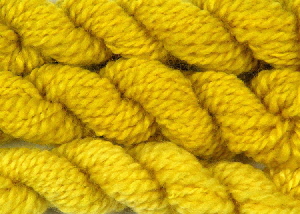|
 Weld produces a wide range of brilliant lemon yellows and can be over-dyed with woad to produce Lincoln Green. Weld produces a wide range of brilliant lemon yellows and can be over-dyed with woad to produce Lincoln Green.
Ingredients
50 g fibres mordanted with alum
25 to 50g dried weld (or 300g fresh weld)
2 to 4 grams of chalk (calcium carbonate) (see troubleshooting below)
5 litres water
1) Dyeing with Dried Weld
2) Dyeing with Fresh Weld
3) Troubleshooting your Weld Dyeing
4) Washing Instructions
1) Dyeing with Dried Weld
Soak the weld in water overnight. Simmer for about an hour but do not allow the weld to boil. Let the dye bath cool and strain and then add fibres and leave them overnight. You can then add more water to the strained weld to try for paler colours.
2) Dyeing with Fresh Weld
Chop the leaves and flower stalks and then add boiling water and simmer for 30 minutes, before proceeding as above. This produces a very bright, almost fluorescent yellow.
Back to top
3) Troubleshooting your Weld Dyeing
Some people get a brilliant lemon yellow with weld with no trouble at all, whilst others only manage to get drab yellows. This may depend on the water that you are using, the soil where the weld has been grown, and how long the dyestuff has been soaked and heated. If you are not getting the colour you want you can try the following:
a) Add chalk: dissolve 2 to 4 grams of chalk (calcium carbonate) with a small amount of boiling water in a container and add to the pot with the weld. Simmer for an hour. This can make an enormous difference to the colour. I found it important to simmer the weld with the chalk rather than just adding the chalk at the end.
b) If you don’t mind the smell, you could try letting the weld ferment in water for a couple of days, either before or after simmering it.
c) Try simmering the weld for 2 hours instead of one.
d) Cold dyeing did not work for me with weld and I found that I had to simmer it for an hour to get a good colour.
Back to top
4) Washing Instructions
Weld is light fast, but dyed fibre or textiles should be washed in cold water, as the dye is slightly soluble in hot water.
Back to Weld Cultivation and Biology; and to dyeing with
Rhubarb
Other Traditional Yellow Dyes
Dyers’ Chamomile, Dyers’ Green-weed, Saw-wort, Tansy
More Yellow Dyes
Dock, Eucalyptus, Onion, Safflower, Goldenrod & Osage Orange
Top of page
|